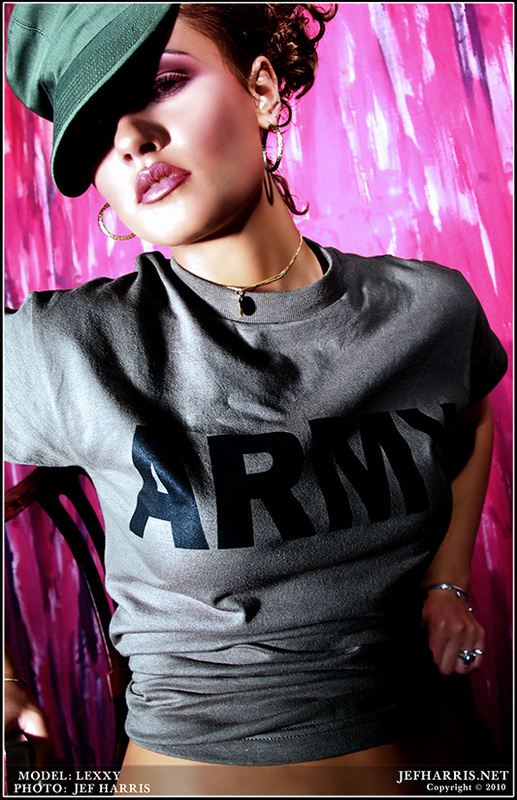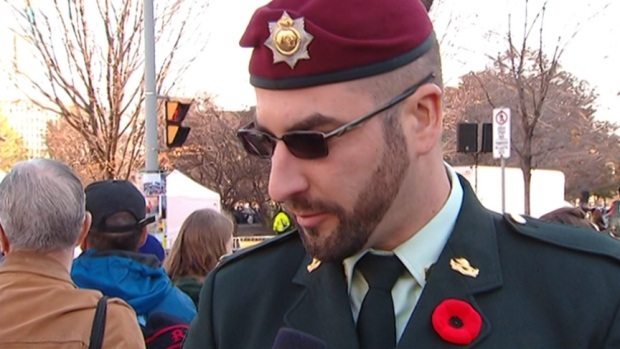INSTRUCTIONSRead this article by Brenna Barks from wornthrough.com, originally titled "Military Appropriations". What do you think of the article? Is it ok to wear military-inspired fashions? When is it appropriation? When is it exchange? Is wearing militaristic fashion in an ironic or protesting way, appropriate? |
However, as Veteran’s Day (Remembrance Day) approached, I considered the military-inspiration in fashion – and my closet – anew. The military is not “my culture”, and I do not have any claim to it. My research focuses on cultural exchange, cross-cultural inspiration, and appropriation, but always in dealing with ethnographic dress or racial issues, not subcultures. At Veteran’s Day, I found myself asking: Is this disrespectful or offensive to those who do and have served? Is it appropriation? And the ever prevalent, are there things we are unintentionally defacing or diminishing because we are outsiders and don’t truly understand what we are copying?Military “appropriation” in fashion is nothing new. It seems to have existed as long as the modern uniform itself. In the mid-eighteenth century, before the British had even finalized the new uniforms for British naval officers, the mariner’s cuff had already crossed over into civilian tailoring.[1]
The adaptation of military details into the women’s riding habit which followed shortly after created an uproar because it hinted at cross dressing (women were accused of “debasing their own femininity”).[2] Queen Victoria dressed the Prince of Wales in miniature sailor’s suits when they were out on the family yacht, starting a fashion trend on both sides of the Atlantic[3]; post-World War I midshipmen’s or “midi” blouses became popular women’s wear (though without the outrage of the riding habit for some reason). By World War II the trench coat was found in as many if not more civilian wardrobes as military ones. Rudi Gernreich caught criticism for his military-inspired collection which came out shortly after the Kent State shootings in 1970. And during the early 1990s “camo” became so popular it came in every colour imaginable and some you probably didn’t. Michael Jackson, The Beatles, and currently Rihanna have worn fantastic versions of the nineteenth-century coats I mentioned above.
Clearly I am not alone in my adoration.
But in the era of Facebook and Google+, I have spent the past three years watching in ways I never could before as former high school classmates, or my younger brother’s friends as they deployed. More than that, I watched my friends who are military families go through the fear for their loved ones’ safety, and comforting each other when they lost someone. So I decided to ask those I know, or friends of those I know, if civilian fashion with military influences was offensive.
The unanimous response was no. Mostly, they have no feelings about it because it doesn’t resemble what they actually wear or wore – it’s more our fantasy versions of military dress. As former Army recruit, Erin Miracle, RVT, pointed out, “[P]ink camo? Are they trying to blend in at the Barbie store?”
Erin did say that if a civilian is going to wear Battle Dress Uniform (BDU) pants or shirts found at surplus stores, they should at least try to wear them properly, in some semblance of regulation style. Making the uniform look sloppy is not respectful. She also said she disapproves of civilians wearing actual dress uniform pieces as a fashion item, even if they found them in a thrift or second hand store, or inherited them from a family member.There is nothing wrong with honoring your ancestors, but if you didn’t earn it, please, don’t wear it (the only exception being young children).
What was truly offensive to Erin, and to my friend Adrienne, whose husband is in the Air Force and was deployed until just a few weeks ago, are the “sexy military officer” costumes that were available at Halloween. Erin told me the sexualization of the uniform, whether on a man or a woman, is like a “slap in the face”. And considering the ongoing prejudice and sexism which women in the military face – some of the rape statistics for enlisted women are as high as one every five minutes – costumes that portray female members of the military as nothing more than sex objects are simply adding insult to injury. Women were not allowed into the military until the twentieth century. It was not until World War I that they were allowed active duty in the Navy – even if that active duty was clerical work or nursing. Since they were not considered as being actively involved, their uniforms imitated fashion, rather than practicality, as can be seen in early photos or WAVES advertisements during World War II.[4]
n the course of my research I ended up skimming the uniform and grooming regulations for all five branches of the military. Having begun life as a dress scholar focusing on the eighteenth-century, I felt like I was in some sort of time warp, where the manners and etiquette of dress from that time were still preserved to a certain extent in these codes and rules. I was particularly amused by a section of the Air Force code which Adrienne pointed out to me which read, “4.1.4. Bow Tie. The bow tie is mandatory and will be white with square ends”. In the military, even bow ties sound official. While I was initially only focused on uniforms, the detailed rules and restrictions on everything from hair, shaving, contacts, and even teeth surprised me.
I asked a former coworker and friend, who is a new Army recruit just out of high school, how difficult it had been to adjust to so many rules for appearance. It did take a bit of getting used to, she said, but for the most part it actually made life easier, though she did say she was uncomfortable wearing the uniform off-base when she wasn’t working because it attracted attention. Adrienne’s husband informed me that while he misses having a beard,the regulations are not as constraining as they might seem on paper. He went on to point out that the military’s purpose and dependence on team efforts, as well as the sheer size of the current U.S. military, mean individuality in appearance cannot be a priority for those in command. He also informed me that more than just “work” and “dress” uniforms, military personnel have specific “uniforms of the day” which vary depending on duties, rank, and the branch in which they are enlisted.
Adrienne’s husband also brought my attention to an aspect of “military-inspired civilian dress” I had not included in my research or questions: the clothing – typically baseball caps, but also jackets, jerseys, and other garments – worn by veterans which declares their history of service to the world. Having just come home from serving in what has now become an unpopular war, it makes perfect sense to me that Adrienne’s husband would want to remind people what these pieces of clothing mean, since so often they just become background. Perhaps it’s a reflection of our society’s attitude about age, since many of them are seniors; perhaps it is, as Erin mentioned, an aspect of certain anti-military sentiments that have been in America since the beginning – Hamilton, after all, opposed a standing army. Since many of those who served in Vietnam or the Korean War, or other unpopular engagements did not make the decisions to invade or intervene – in fact many of them were drafted – perhaps they deserve a bit more respect for the courage it takes to say “I was there”.
The United States Navy’s Uniform and Grooming regulations state that uniforms “are distinctive visual evidence of the authority and responsibility vested in their wearer by the United States”[5]. It’s good to know that fashion has not appropriated that, but merely been inspired by it.


 RSS Feed
RSS Feed